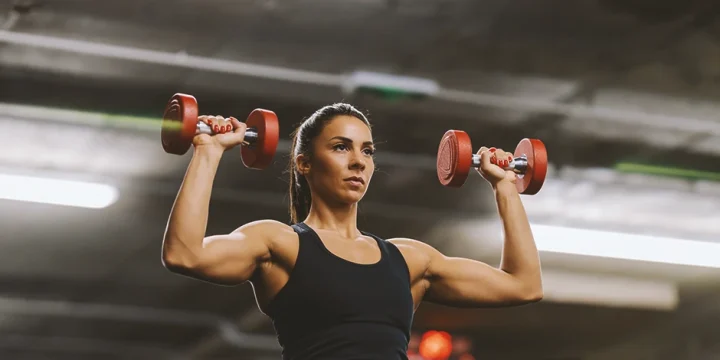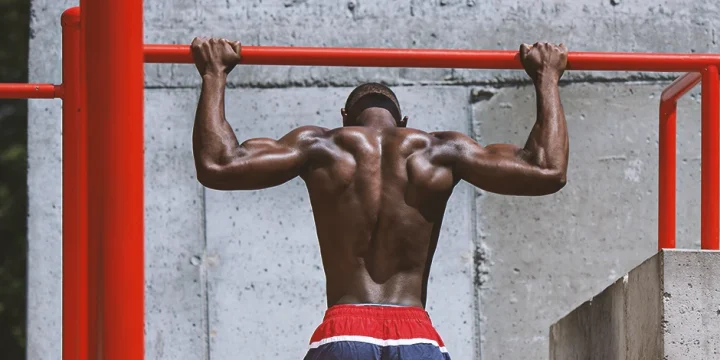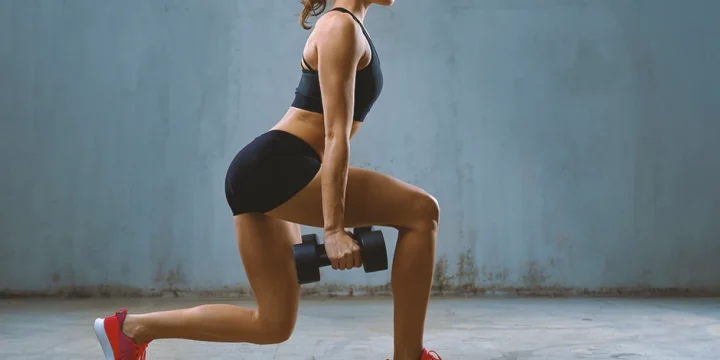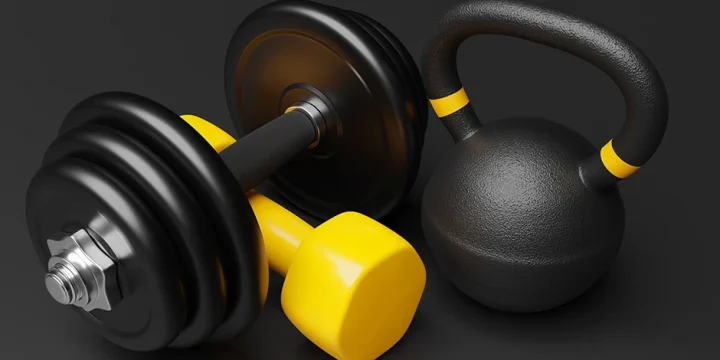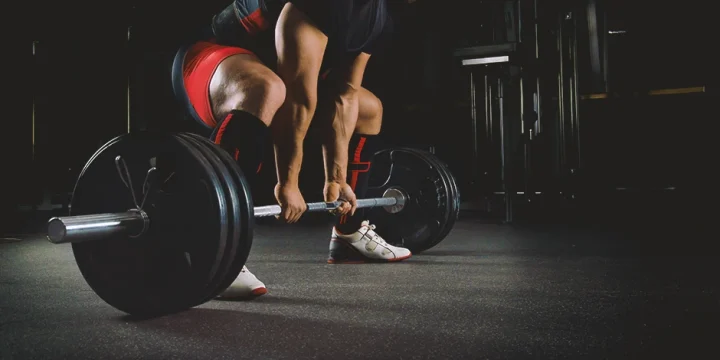If you spend a lot of time sitting at a desk or driving, chances are your back muscles are weak and tight, and this can lead to poor posture and chronic back pain
As a certified personal trainer, I’ve decided to help my clients and readers avoid these issues, so after thorough research, I’ve compiled a list of the most effective dumbbell back exercises that yield visible results and give you better back symmetry.
If you want a V-shaped back, grab a pair of dumbbells, and let’s get started!
Quick Summary
- To effectively strengthen and define the back muscles, incorporate exercises like the dumbbell bent-over row, single-arm row, and renegade row into your workout routine.
- These exercises focus on key back muscles like the latissimus dorsi, rhomboids, trapezius, and erector spinae, offering a balanced workout for back development.
- A study on the National Center for Biotechnology Information website indicates that during bilateral rowing exercises, the external oblique's EMG activities were only 37-41% of those in unilateral performance.
- Based on my experience, these exercises are designed not only to build muscle but also to improve posture, reduce back pain, and enhance overall back function, making them suitable for a wide range of fitness enthusiasts.
10 Effective Dumbbell Exercises for a Defined Back

Before getting into the best dumbbell exercises for your back, let’s look at how dumbbells are an effective way to sculpt and strengthen back muscles.
Can You Build Your Back With Dumbbells?
Yes, you can build your back with dumbbells. Dumbbells give the option of working the muscles on your back from different angles, allowing you to target more specific areas for strength and hypertrophy.
A good dumbbell workout includes exercises like rows, pullovers, and flys, all of which can be done at home or the gym with just a few sets of dumbbells.
10 Best Dumbbell Exercises For Your Back

We have compiled this list after observing various clients’ back transformation journeys. These exercises are easy to perform at home or at the gym.
“The only way to isolate specific back muscles — whether it is upper or lower back — or make any progress is through the power of the mind-muscle connection.”
- Lee Haney, American Bodybuilder
1. Dumbbell Bent Over Row
This is a compound exercise that works the upper and mid-back muscles as well as the biceps.
According to one of the studies found on the National Center for Biotechnology Information website, the standing bent-over row elicited large muscle activation symmetrically from the upper to lower back [1].
It allows you to work each side of the back individually, preventing muscle imbalances.
To perform the bent-over dumbbell row:
- Stand with feet shoulder-width apart, holding a dumbbell in each hand with palms facing your body.
- Hinge forward at the hips, keeping your back flat and core engaged.
- Lift both dumbbells towards your chest, keeping elbows close to your body and squeezing shoulder blades together.
- Lower dumbbells back down to starting position, maintaining control and avoiding jerky movements.
2. Single Arm Dumbbell Row
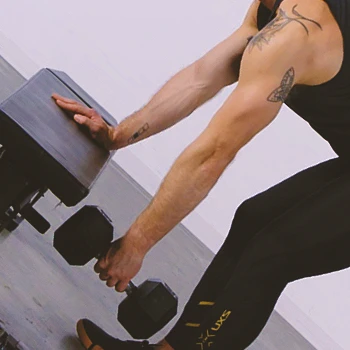
The single-arm dumbbell row is a classic exercise that targets the upper back muscles, including the latissimus dorsi, rhomboids, and trapezius.
This unilateral exercise improves muscle imbalances, challenges core muscles, and develops a strong, defined back.
One of the studies from the National Center for Biotechnology Information website compared core muscle activation in 3 different row exercises.
It aimed to measure the effect of performing bilateral and unilateral row exercises on core muscle activation.
The study concluded that unilateral performance of exercises activated the external oblique more than bilateral performance, regardless of exercise [2].
To perform the single-arm dumbbell row:
- Stand with feet hip-width apart, and hold a dumbbell in your right hand with a neutral grip.
- Hinge at hips, keeping back flat and core engaged until the torso is parallel to the ground.
- Pull the dumbbell towards your waist, and squeeze your shoulder blades together.
- Slowly lower the dumbbell back down.
- Switch sides and repeat with the left arm.
3. Dumbbell Renegade Row
The dumbbell renegade row is a challenging exercise that targets your entire back while engaging your core and arms.
It is a favorite in my training routines. It's not just a back exercise; it's a full-body challenge that tests and improves your core stability, which I always find crucial for overall fitness.
To perform the dumbbell renegade row:
- Start in a high plank with hands holding dumbbells on the ground, shoulder-width apart.
- Keep your body straight, with your core engaged.
- Row one dumbbell towards your side, elbow close to your body, squeezing your shoulder blades.
- Lower the dumbbell and repeat on the opposite side.
4. Dumbbell Upright Row
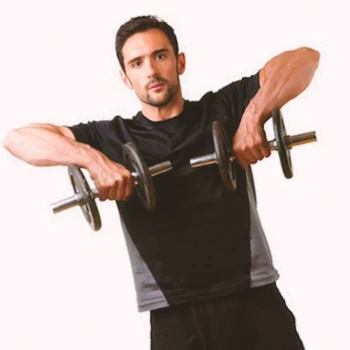
The dumbbell upright row is an excellent exercise for targeting the shoulders, traps, and back.
It involves lifting dumbbells vertically towards the shoulders while keeping the elbows high and close to the body.
I often include the dumbbell upright row in my clients' routines for its versatility. It's amazing for targeting the traps and upper back, and I've seen significant improvements in posture and shoulder strength.
Here's how to perform it:
- Stand with feet hip-width apart and hold dumbbells in front of you with an overhand grip.
- Lift dumbbells towards the chest, keeping elbows close to the body.
- Pause at the top, squeezing shoulders and upper back.
- Slowly lower the dumbbells back down to starting position.
5. Chest-Supported Dumbbell Row
This exercise is performed lying face down on an incline bench with your chest supported and your arms hanging straight down.
The chest-supported dumbbell row is excellent for clients who have lower back issues.
It allows them to focus on strengthening their back without the strain, and I've used it successfully with many who have back concerns.
Here’s how to perform it:
- Face down on a flat bench with feet flat on the ground and chest supported.
- Grab dumbbells with palms facing each other and arms extended toward the ground.
- Pull the dumbbells towards your ribcage, keeping elbows close to your body.
- Squeeze shoulder blades at the top before lowering weights to starting position.
- Repeat for desired reps while maintaining control and form.
6. Dumbbell Pullover
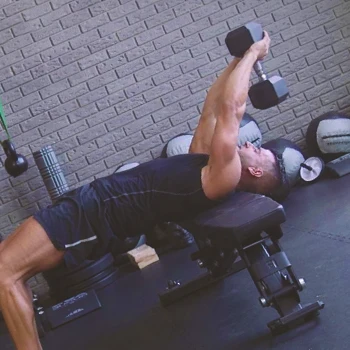
The dumbbell pullover is an excellent upper-body exercise that targets the chest, back, and triceps muscles.
This exercise is performed lying on a bench and involves a controlled movement of the dumbbell overhead while maintaining stability throughout the body.
To perform the exercise:
- Lie on a bench with your feet flat on the ground and your head and shoulders supported.
- Hold a dumbbell with both hands and extend it above your chest.
- Slowly lower the weight behind your head, keeping your elbows slightly bent.
- Pause briefly, then raise the dumbbell back up to the starting position.
- Repeat for your desired reps, keeping your core engaged and controlling the movement.
7. Good Morning
This exercise involves a hip hinge movement pattern that mimics the motion of bending forward, similar to how you would bow when greeting someone.
To perform the exercise:
- Stand with your feet shoulder-width apart, hold a dumbbell with both hands, resting it on the back of your neck.
- Hinge forward at the hips, push your glutes back, and lower your chest.
- Lower down with the knees slightly bent until you feel a stretch in your hamstrings without rounding your back.
- Push your hips forward and stand back up to the starting position.
8. Dumbbell Deadlift
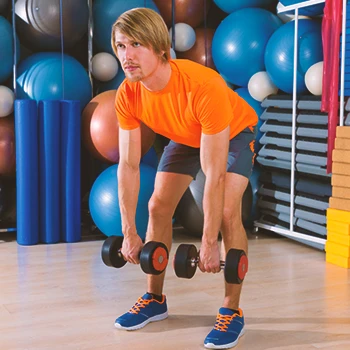
The dumbbell deadlift is a compound exercise that targets multiple muscle groups, including the hamstrings, glutes, lower back, and forearms.
It’s an excellent exercise for developing overall strength and can be performed with a pair of dumbbells.
How to perform the dumbbell deadlift:
- Stand with your feet shoulder-width apart, a dumbbell in each hand, and arms extended in front.
- Hinge at the hips, lowering the torso while keeping the back straight and core engaged.
- Lower the dumbbells, keeping them close to the body.
- Once they reach below knees, push through the heels to return to starting position.
- Squeeze the glutes at the top to engage the hamstrings.
9. Reverse Fly
The reverse fly is a resistance training exercise that targets the upper back and shoulder muscles, particularly the rear deltoids.
It’s performed using dumbbells and can be modified to suit different fitness levels.
To perform a reverse fly with dumbbells:
- Begin by standing with your feet shoulder-width apart and holding a dumbbell in each hand.
- Hinge forward at the hips, keeping your back straight and your knees slightly bent.
- With your palms facing each other, lift your arms to the sides until they parallel to the ground.
- Squeeze your shoulder blades together at the top of the movement, then slowly lower the weights.
10. Farmer’s Carry
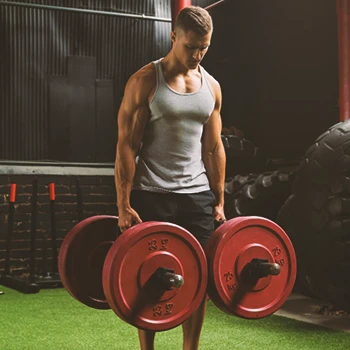
The farmer’s carry is a compound exercise that targets multiple muscles, including the forearms, upper back, shoulders, and core.
It involves holding a heavy dumbbell in each hand and walking for a certain distance or time.
To perform the farmer’s carry:
- Stand tall with your feet shoulder-width apart and your core engaged.
- Pick up the dumbbells with a neutral grip and hold them by your sides.
- Walk forward with small steps, maintaining control on both the right and left leg.
- Keep your shoulders, back, abs, and glutes tight and your gaze straight ahead.
- Continue walking for a set distance or time or until you feel fatigued.
Benefits of These Workouts
Dumbbell back exercises strengthen the muscles in your back, which can reduce back pain, particularly in the lower back, which is often susceptible to strains and sprains [3].
“An episode of acute low back pain is a call to action for people who are simply not exercisers.”
- Dr. Jeffrey N. Katz, Professor of Orthopedic Surgery
Strong back muscles can improve posture by pulling the shoulders back and down, reducing the risk of developing rounded shoulders and a hunched back.
Regular strength training with dumbbells can also enhance bone density and muscle growth, lower blood pressure, and improve insulin sensitivity [4].
Equipment Needed
Dumbbell back workouts can be done with various equipment, but the basic requirement is a set of dumbbells.
Get a range of weights to accommodate different exercises and strength levels.
Other equipment includes a flat bench for dumbbell rows, an incline bench for chest-supported dumbbell rows, and resistance bands to add variety.
Also Read: Best Dumbbell Racks
Muscles Worked

Dumbbell back exercises build and strengthen the following muscles in the back:
- Latissimus dorsi: Located on either side of the back, the lats pull the arms down and towards the body.
- Trapezius: A large muscle that covers the upper back and neck; it stabilizes the shoulder blades and controls the neck movements.
- Rhomboids: Located in the middle of the upper back, the rhomboids retract the shoulder blades and maintain good posture.
- Erector spinae: These muscles run along the spine and extend the back and maintain good posture.
- Rear deltoids: The posterior head of the shoulder muscle fibers, rear delts extend and externally rotate the arm and assist in pulling movements.
FAQs
Which Exercises Work the Back the Best?
Exercises that work the back the best include pull-ups, lat pulldowns, the dumbbell bent-over row, the dumbbell chest-supported row, and dumbbell deadlifts.
How Do I Strengthen My Back With Dumbbells?
You can strengthen your back with dumbbells by performing various dumbbell variations of barbell exercises. This allows you to target major muscle groups on your back from various angles.
How Can Dumbbell Back Exercises Be Integrated into Rehabilitation Programs?
Dumbbell back exercises can be highly effective in rehabilitation programs for those recovering from back injuries. They offer controlled, targeted movements that strengthen back muscles and improve flexibility, aiding in a quicker and safer recovery.
What Are the Best Dumbbell Back Exercises for Older Adults?
For older adults, dumbbell back exercises should focus on improving posture and strengthening the back to combat age-related issues. Exercises like the seated row and standing reverse fly are ideal, as they are low-impact yet effective in building back strength.
How Do Dumbbell Back Exercises Impact Posture Correction?
Regularly performing dumbbell back exercises can significantly improve posture, especially for individuals with sedentary lifestyles. These exercises strengthen the back muscles responsible for maintaining upright posture, thereby reducing the likelihood of slouching and back pain.
Can Dumbbell Back Exercises Benefit Mental Health?
Engaging in dumbbell back exercises can have a positive impact on mental health by reducing stress and improving mood. Physical activity stimulates endorphin release, which is known for its mood-boosting and stress-relieving effects.
References:
- https://pubmed.ncbi.nlm.nih.gov/19197209/
- https://pubmed.ncbi.nlm.nih.gov/26134664/
- https://www.ncbi.nlm.nih.gov/pmc/articles/PMC4934575/
- https://www.ncbi.nlm.nih.gov/pmc/articles/PMC6279907/
About The Author
You May Also Like
